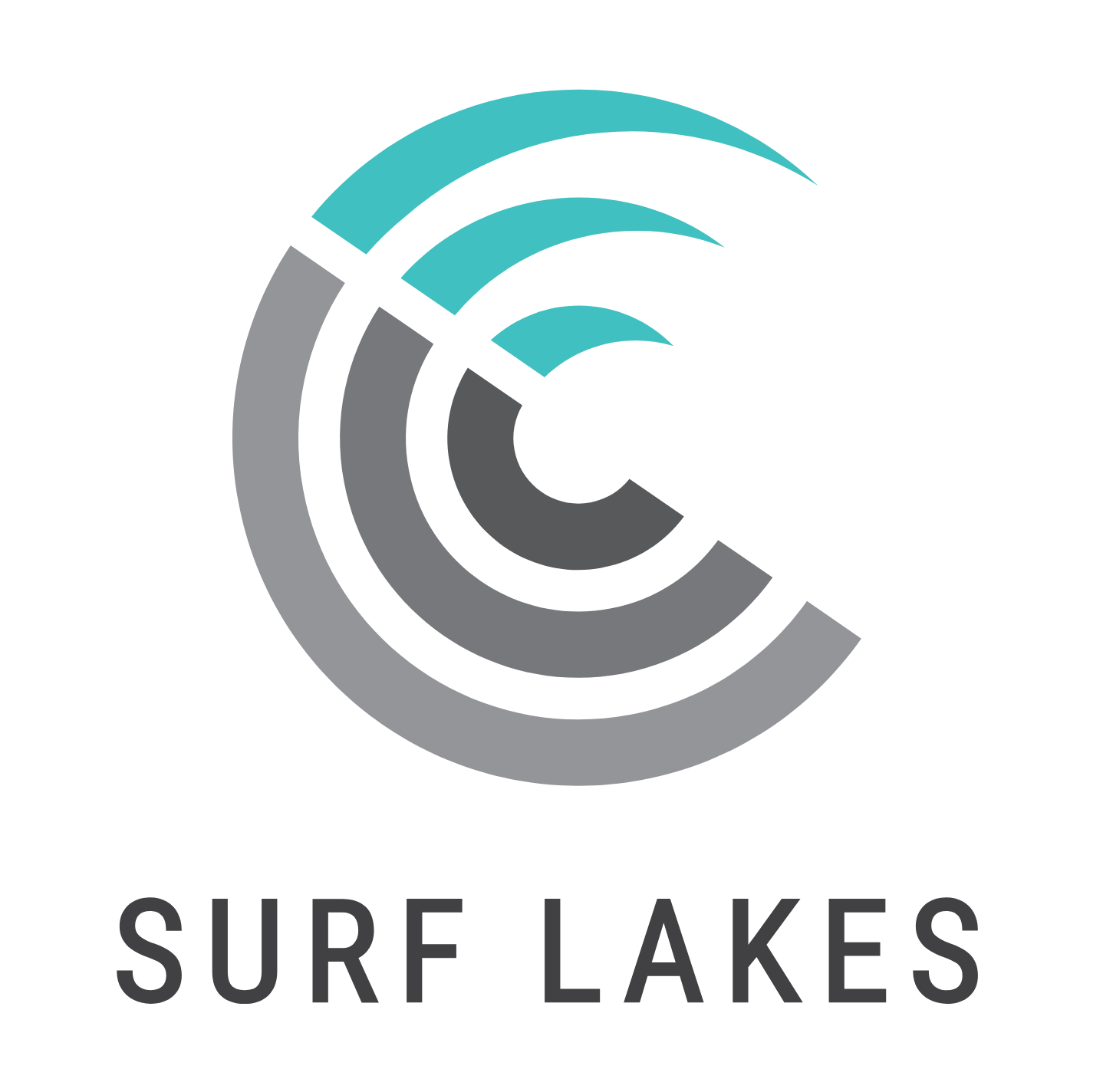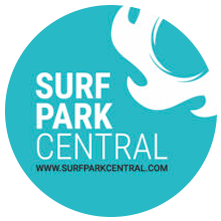
WSL Pro Surfer Stephanie Gilmore clearly enjoying her first man-made barrels. Photo: Kelly Slater Wave Company
LA Times on Wave Pools and Man-Made Wave Technology
California’s ‘perfect’ surfing wave comes from a machine on a patch of old farmland
Originally published on LATimes.com on May 4, 2016
Words by Joe Mozingo, Contact Reporter
Surfers had never seen a spot like it: head-high waves unfurling like wrapping paper in pristine, tapering cylinders for more than a quarter-mile, with not a soul out to catch them.
But something about the scene was amiss. Between waves, ducks floated in dead-still water the color of tea. A dusty eucalyptus windbreak lined the shore. And the breakers didn’t have the bumps, boils and warbles that blemish even the cleanest ocean waves.
Because they were not ocean waves. They did not come from a storm out at sea.
They came from a machine on a patch of old farmland — and sent a shiver of awe through the surfing world from South Africa to Santa Cruz.
Within a week of 11-time world champion Kelly Slater uploading video of him riding the wave in December, it had 9 million views.
Every surfer daydreams about a perfectly shaped wave that they can ride again and again, away from the bobbing masses that have turned even mediocre breaks into the oceanic equivalent of a Starbucks parking lot.
Entrepreneurs fantasize about the cash they can make by breaking out of those natural confines. The sport and lifestyle already has spawned an industry worth tens of billions of dollars in specialized equipment, clothing, media and global tourism.
Surf patois and fashion long ago infiltrated the nation’s landlocked hinterlands. Now rival teams of technological innovators are trying like never before to bring the sport itself there, vying for patents and funding to make the dream of a man-made Pipeline or Rincon come true.

Kelly Slater locking into a perfectly shaped barrel. Photo: Todd Glaser & Kelly Slater Wave Company
For 10 years, Slater had been working with a team that includes a USC aerospace engineer to beat competitors in Spain, Germany, Australia and San Diego.
He hasn’t won the race; it’s not clear how many waves an hour his pool can produce, or how much energy is consumed doing it. But he cleared a hurdle no one else has.
“A wave of that shape sits in the subconsciousness of every surfer in the world,” says longtime Surfer magazine editor Steve Hawk. “That wave is exactly the fantasy wave I drew on the margins of my notebooks when I was in high school.”
Slater kept his “secret spot” shrouded in mystery. He didn’t say where it was, other than “110 miles from the coast.” He hasn’t said if the wave pool will be open to the public.
But the sight of him carving across his waves’ uniformly steep faces and repeatedly snapping sharp cutbacks to slip into its dark liquid tube — once for an astoundingly long 17 seconds — was too much to leave alone.
Within days, Web sleuths and surf media, knowing his company warehouse was in Los Angeles, had zeroed in on a nearly half-mile-long former water-skiing pond outside the Central Valley town of Lemoore.
Great events in surfing history have occurred on jagged coasts and far-flung tropical reefs from Half Moon Bay to Tasmania.
No one expected a big one to occur on a back road to Fresno.
Surfers from California to Australia conducted pilgrimages to see the wave, only to be turned away by a locked plank gate and a security guard.
After failing to get through to Slater for an interview, a Times reporter made the trek and peeked through a back fence. But the wave monster was sleeping.
“When I saw Slater’s wave for the first time, it almost made me feel dizzy, like vertigo,” says Matt Warshaw, a longtime surf writer and author of “The Encyclopedia of Surfing.” “This changes fundamental things about how we feel about surfing.”
For many in the industry, it stirs hopes of creating big destination surf parks, expanding the market not just to inland spots but to coastal areas that don’t get decent surf. It might be what gets surfing into the Olympics, possibly in Japan in 2020.
All of which torments purists, even those frothing with desire for Slater’s wave. The elusive, forever-changing quality of ocean waves gives surfing its thrill and challenge, they say. Surfers spend their lives silently learning the quirks of their breaks, the vastly complex combination of tide, current, wind, swell and bathymetry.
And the heavier the conditions get, the more they feed off the adrenaline rush of speed, power and the real risk of drowning.
“The thing that makes surfing so exciting, that makes it sink into your marrow, is that there are these fleeting moments of perfection in all this chaos,” says Hawk, “and you have this hard-learned ability to … hunt them down.”
Hawk says surfing in wave pools will require none of the skills and intuition surfers develop over decades. They won’t even have to develop the unique musculature and timing to paddle a board through incoming surf to get to the break — they can just get out and walk.
“We might have an Olympic champion surfer who has never duck-dived under a wave, never jumped off a jetty, never put on a leash, never been scared out of their wits,” he says. “I find that future thoroughly disheartening. It’s not real surfing.”
Thomas Lochtefeld, a longtime La Jolla surfer and owner of an artificial wave company in San Diego, agrees that it won’t be the same.
He sees the pools as places people can take their first surf lessons, where surfers can practice their wave-riding, and where they can take a vacation and be certain of catching a large quantity of excellent waves.
To the purists, he says: “Hey, go surf in the ocean.”
The first wave park for U.S. surfers opened in Tempe, Ariz., in 1969, funded by Clairol, the hair-coloring company. The wave was formed by the sudden release of millions of gallons of water down a 40-foot column into the pool through underwater grates, creating a pulse that rolled to the other side and broke as the depth got shallower.
The rides were small and mushy, and the pool catered mostly to children and non-surfers who enjoyed frolicking in the water on inflatable rafts and boogie boards. Many wave pools followed, using the same basic technology.
Then in the late 1980s, Lochtefeld, an entrepreneur who co-founded Raging Waters in San Dimas, noticed that when he surfed his home break of Big Rock in La Jolla, he’d often come to parts of the reef where he was gliding in only inches of water.
He and a team of friends developed FlowRider, which sent a thin sheet of water — 100,000 gallons a minute — racing up a foam-covered concrete structure designed like a cresting wave that steepened from a low shoulder on one side to a concave vertical peak on the other, where the water toppled back and created the sacred tube.
Lochtefeld says he has sold a couple hundred sheet waves — to cruise ships, water parks, even Arab sheiks, including the crown prince of Abu Dhabi — for about $1.2 million apiece. The wave offered more of a challenge and thrill than the mushy wave pools, but the sensation still didn’t remotely match surfing.
It wasn’t until 2011 that the surf world first gasped at a decent-size, great-shaped artificial wave.

The Wavegarden at Surf Snowdonia in action during the Red Bull Unleashed event last year. Coming back for 2016… Photo: Red Bull
A Basque engineer, Josema Odriozola, and a German sports economist, Karin Frisch, both surfers, developed a technology to make better waves with less energy. Under a long steel pier in a man-made 250-meter-long lagoon, they towed a kind of plow, or foil, along tracks underwater, pushing a wave up and outward. Both the foil and the bottom of the lagoon were tuned so that the wave tapered smoothly as it broke, allowing long rides.
They opened their first park in Snowdownia, Wales, in July 2015. The surf media anointed it as the best there ever was. But it has been beset by technical problems and closures. WaveGarden is now building a longer lagoon in Austin, Texas, that is expected to open this spring, and it is planning two more in Australia.
A spokesman for WaveGarden, Felip Verger, says that though the parks will be capable of making bigger waves like Slater’s, they probably won’t, because that would raise energy costs and reduce the number of waves, meaning fewer surfers could be in the lagoon at a time.
This is the technological conundrum.
Slater’s wave operates by the same basic method of towing a foil through the water.
The video shows a maelstrom of backwash behind the wave that would take time to settle before another wave could roll through.
In San Diego, Lochtefeld, 63, says that is the “kiss of death” for any commercial venture, in which a wave needs to roll every 10 to 20 seconds.
Lochtefeld’s company sits on the rim of a canyon in Mira Mesa, where the miniature surf pool he is using to test his designs draws thirsty rattlesnakes from the scrub.
On a recent morning, perfect 6-inchers peeled across the 40-foot pool, barreling all the way: a dream wave for a plastic action figure. A dozen separate airtight caissons are mounted to the wall at the deep end of the pool, each one reaching beneath the surface. Pneumatics create a vacuum to pull water up into the caissons, creating a trough in the pool, then push it down to create a crest. Just as in the ocean, the wave crest follows the trough.
The caissons do this within seconds of each other, and slight differences in timing change the shape of the wave. “It’s like tuning a piano,” Lochtefeld says.
Justin Enjo, his coastal engineer, adjusts the timing on the computer.
The little wave breaks first from the right end and then from the left end, so that a rider looking to do an aerial maneuver could launch off the left break.
Lochtefeld says he can build a Slater-style wave without the same displacement of water. His wave, he says, is more like snapping the end of a long rope and watching the pulse move to the other end. The rope itself is not moved horizontally at all. The energy is vertical.
“You lift the water up and drop it, or push it down and it comes back. We call it harmonic. The energy goes out in the pool and then it’s going to come back, and you just take advantage of it and put it into the next wave. It’s all a part of the frequency.”
This pool is a 1/15-scale model of what he plans to build in a 425-foot length of canal in Rotterdam, Netherlands.

Rendering of SurfLoch Surf Pools RiF010 project under development in Rotterdam, Netherlands
After Rotterdam, he plans to build a 650-foot pool, with bigger waves (up to 7 seven feet) in Bristol, England.
“Bristol is going to be the Ferrari,” Enjo adds.
His overall goal is to create areas where hotel, retail and food and beverage space surround the waves. Surfing will be the entertainment.
Warshaw dreads the moment when visiting such venues takes the place of venturing to far-flung islands such as the Mentawais, off Indonesia, or the Skeleton Coast of Namibia, where the waves can be perfect — but they might not come during your vacation.
With total predictability, it’ll feel routine, he says.
“Why are we so excited about standing in a tube of water?” Warshaw asks. “The attraction to it comes from how different it is, and how rare it is.
“A wave pool takes it all away.”
That firm belief puts Warshaw, and many other surfers, in a moral quandary.
So, if Slater called and …
“I’d be on a plane before dinner.”






























2 Comments
You must be logged in to post a comment Login